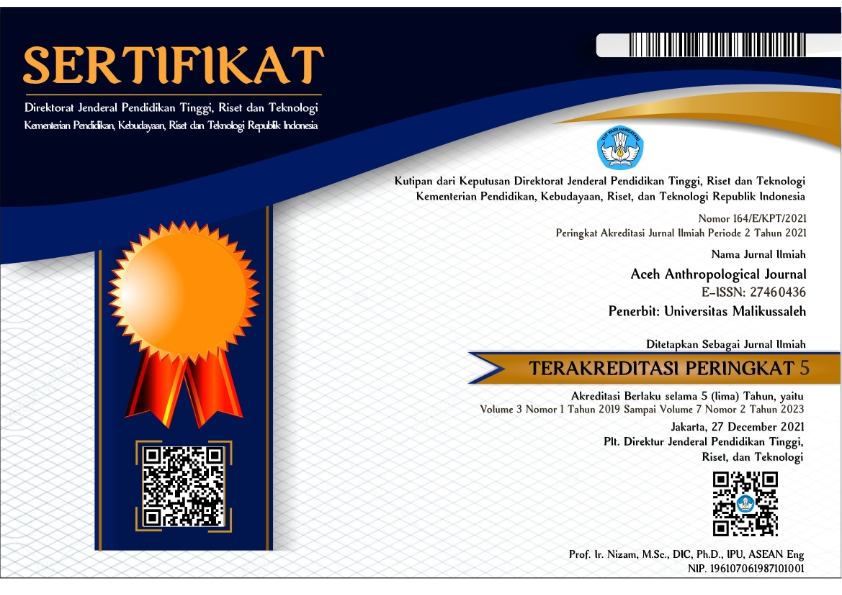Eksistensi Masyarakat Pesisir di Sibolga: Studi Etnografi Tentang Keberadaan Etnis Pesisir di Sibolga
Abstract
Abtract: This research departs from the anxiety of the people of Sibolga who call themselves the Coastal people in Sibolga and its surroundings. This anxiety arises because of the unclear position of their position as an ethnic unit with the Coastal culture that they have and is still applied to this day in their lives, namely the Coastal culture or also called the Sumando culture. The population data from the Population and Civil Registry Office (disdukcapil) of the city of Sibolga also does not state the presence of Coastal ethnicity, while other ethnicities such as Batak, Minang, Acehnese, Nias, Javanese and others are clearly listed. The last one is the Decree of the Mayor of Medan No. 025/02.K/VIII/2021 concerning Regional Customary Service Clothing in North Sumatra also does not mention the Coastal ethnicity. This research was conducted with a qualitative method. From the observations, it can be seen that in public places/locations there are three languages used by the community in interacting, namely the National (Indonesian) language, the Coastal language and the Batak language. However, there is a dominant use based on region, for example in the Sibolga Kota sub-district the dominant language is Indonesian, except for the Pasar Behind sub-district, the coastal language is dominant, the North Sibolga sub-district is Batak dominant, while in the Sibolga Sambas sub-district and the South Sibolga sub-district, the coastal language is dominant. As for traditional activities which include weddings, deaths or others, we will find that there are two dominant ethnic customs, namely the Coastal and Batak customs. In line with the religion, the Sibolga community consists of two dominant religions, namely Islam and Christianity.
Abstrak: Penelitian ini berangkat dari kegelisahan masyarakat Sibolga yang menamakan dirinya masyarakat Pesisir di Sibolga dan sekitarnya. Kecemasan ini muncul karena ketidakjelasan posisi mereka sebagai satu kesatuan etnis dengan budaya pesisir yang mereka miliki dan masih diterapkan hingga saat ini dalam kehidupan mereka, yaitu budaya Sumando. Data kependudukan dari Dinas Kependudukan dan Catatan Sipil (disdukcapil) kota Sibolga juga tidak menyebutkan adanya etnis Pesisir, sedangkan etnis lain seperti Batak, Minang, Aceh, Nias, Jawa dan lain-lain dicantumkan dengan jelas. Terakhir, SK Walikota Medan No. 025/02.K/VIII/2021 tentang Pakaian Dinas Adat Daerah di Sumut juga tidak menyebutkan etnis Pesisir. Penelitian ini dilakukan dengan metode kualitatif. Dari pengamatan terlihat bahwa di tempat/lokasi umum terdapat tiga bahasa yang digunakan masyarakat dalam berinteraksi, yaitu bahasa Nasional (Indonesia), bahasa Pesisir dan bahasa Batak. Namun terdapat penggunaan yang dominan berdasarkan wilayah, misalnya di Kecamatan Sibolga Kota bahasa yang dominan adalah bahasa Indonesia, kecuali untuk kecamatan Pasar Behind, bahasa pesisir lebih dominan, kecamatan Sibolga Utara dominan bahasa Batak, sedangkan di Kecamatan Sibolga Sambas dan Kecamatan Sibolga Selatan bahasa pesisir lebih dominan. Adapun kegiatan adat yang meliputi pernikahan, kematian atau lainnya, kita menemukan ada dua adat etnis yang dominan, yaitu adat Pesisir dan Batak. Sejalan dengan agama, masyarakat Sibolga terdiri dari dua agama dominan, yaitu Islam dan Kristen.
Keywords
Full Text:
PDFReferences
Aminah, S. 2014, Kuasa Negara pada Ranah Politik Lokal, Prenadamedia Group, Jakarta.
Ambardi, K. Munaji dan Liddle, R.W. 2012. Kuasa Rakyat: Analisis Perilaku Memilih Indonesia Pasca Orde Baru (Peopel Power: An Analysis of Post Ner Order Indonesian Voting Behaviour). Bandung: Mizan.
Aragon,L.V. 2014. Persaingan Elit di Sulawesi Tengah, dalam Nordholt, Henk
Schulte, dkk (Ed). Politik Lokal di Indonesia, Penerbit Yayasan Pustaka Obor Indonesia.
Aronof, M. J & Jan K. 2013. Anthropology and Political Science, Berghalm Books, New York, USA.
Aspinall, E. 2011. Democratization and Ethnic Politics in Indonesia: Nine Theses. Journal of East Asian Studies 11(2011), 289-319.
Castle, L. 2001 . Kehidupan Politik Suatu Keresidenan di Sumatra: Tapanuli 1915-1940. KPG.
Castells, M. 2010. The Power of Identity: The Information Age - Economy, Society, and Culture: Volume II. Wiley-Blackwell.
Drakard, J. 2003. Sejarah Raja-Raja Barus; Dua Naskah dari Barus. Gramedia Pustaka Utama – Ecole Francaise d’Extreme-Orient, Jakarta
Drakeley, S. 2014. Indonesia’s Low Quality Democracy Consolidated: The Danger of Drift and Corrosion in Democracy in Eastern Asia: Issues, Problems and Challenges in a Region of Diversity. Edmund S.K. Fung and Steven Drakeley (Eds). Routledge, New York
Eindhoven, M. 2014. Penjajah Baru? Identitas, Refresentasi, dan Pemerintahan di Kepulauan Mentawai Pasca-Orde Baru, dalam Nordholt, Henk Schulte dkk, (Ed). Politik Lokal di Indonesia, Penerbit yayasan Pustaka Obor Indonesia.
Eriksen, T H. 2010. Ethnicity and Nationalism Anthropological Perspectives. London: Pluto Press.
Fife, W, 2005. Doing Fieldwork: Ethnographic Methods for Research in Developing Countries and Beyond, Palgrave Macmillan, Library of Congress, USA
Goodenough, W. E. 1970. Description and Comparison in Cultural Anthropology. United States of America: Cambridge University Press.
Hadi, V. R, 1992. Politik, Budaya dan Perubahan Sosial: Ben Anderson dalam Studi Poliitk Indonesia, Gramedia – LP3ES, Jakarta
Hefner, R.W. 2001. Civil Islam; Islam dan Demokratisasi di Indonesia. Institut Studi Arus Informasi.
Hutapea, R.P. 2015, Tesis dengan judul “Faktor faktor yang mempengaruhi pemilih pada masyarakat Samosir pada Pra Pemilihan Bupati dan Wakil Bupati Samosir Tahun 2015”. Magister Studi Pembanguan, USU,
Irfan (2020), Orang Batak dan UrangPasisi di Sibolga. Disertasi Doktor Program Antropologi Fisip UI. (belum diterbitkan) www,ui.ac.id
Kartikatanri, A.D. Priyatna, Centurion C. Dan Hanny H. 2015. Perbedaan Sikap Pemilih Pemula Antara Peserta dan Bukan Bukan Peserta “Roadshow Pendidikan Pemilu.” Jurnal Komunikasi Vol. 7, No. 1, Juli 2015, Hal 26 – 40
Kottak, C.P. 2007. Mirror for Humaniy; A Concise Introduction to Cultural Anthropology (fifth edition). Mc Graw Hill Higher Education: New York.
Kozok, U. 2009. Surat Batak; Sejarah Perkembangan Tulisan Batak Berikut Pedoman Menulis Aksara Batak dan Cap Si Singamangaraja XII. Kepustakaan Populer Gramedia, Jakarta.
Matondang, I. A. 2013. Kajian Bentuk Penggunaan dan Ruang Pertunjukan Gordang Sambilan di Kota Medan. Tesis. Program Pasca Sarjana Antropologi, Prodi Antropologi Sosial Universitas Negeri Medan
Malinowski, B. 1944. A Scientific Theory of Culture. Chapel Hill: University of North Carolina Press.
Marijan, K, 2013. “Ilmu Politik dalam Paradigma Abad 21” Jilid 1 (ed) John T. Ishiyama dan Marijke Breuning, Kencana Prenada Media Gorup, Jakarta
Matsumoto, D. 2007. Culture, Context, and Behavior. Journal of Personality 75: 6, Blackwell Publishing, Inc. (p. 1286-1320).
Maunati.Y. 2004. Identitas Dayak; Komodifikasi dan Politik Kebudayaan. Yogyakarta: Penerbit Lkis.
Mc Glynn, Frank dan Arthur Tuden (Ed). 2000. Pendekatan Antropologi pada Prilaku Politik.UI Press, Jakarta
Pelly, U. 2016, Etnisitas dalam Politik Multikultural Buku III, Medan, Casa Mesra Pubslisher
Reid, A, Is There a Batak History? (November 1, 2006). Asia Research Institute Working Paper No. 78.
Roberts, B. W. 2006. Personality Development and Organizational Behavior (pp. 1–41). In B.M. Staw (Ed.), Research on Organizational Behavior. Elsevier Science, JAI Press.
Rodriguez, J. B. Global Art And Politics Of Mobility: (Trans)Cultural Shifts in the international contemporary art-sistem. ASCA.
Simanjuntak, D. 2018. North Sumatra’s 2018 Election: Identity Politics Ruled the Day. Http//www.iseas.edu.sg./images/pdf/ISEAS_Perspective_2018_60@50.pdf
Simanjuntak, B,A. 2011. Pemikiran Tentang Batak. Yayasan Pustaka Obor Indonesia Jakarta
Sjaf, Sofyan. 2014. Politik Etnik, Dinamika Politik Lokal di Kendari. Yayasan Pustaka Obor Indomesia Jakarta.
Tanjung, I. L, dkk. 2016. Colonial Politics in Forming Ethnic Identity of Melayu Minangkabau and Batak in Tapanuli. Jurnal Humaniora Volume 28 No.1 Februari 2016, Hal. 106-114
Van M J. 1996. Ethnography. Dalam A. Kuper and J. Kuper (Eds) The Social Science Encyclopedia, 2nd ed., pages 263-265. London: Routledge.
Weedon, C. 2004. Identity and Culture: Narratives of Difference and Belonging: Narratives of Difference and Belonging (Issues in Cultural & Media Studies). Open University Press.
DOI: https://doi.org/10.29103/aaj.v6i2.6866
 Article Metrics
Article Metrics
 Abstract Views : 342 times
Abstract Views : 342 times
Refbacks
- There are currently no refbacks.
Copyright (c) 2022 Irfan Simatupang
INDEXED BY:










Redaksi Aceh Anthropological Journal (AAJ): Gedung Program Studi Antropologi Fakultas Ilmu Sosial dan Ilmu Politik Universitas Malikussaleh. Kampus Bukit Indah Jln. Sumatera No.8, Kec. Muara Satu Kota Lhokseumawe, Prov. Aceh, Indonesia. eMail: aaj.antro@unimal.ac.id
All publication by Aceh Anthropological Journal (AAJ) are licensed under a Lisensi Creative Commons Atribusi 4.0 Internasional





.png)
.png)
.png)

